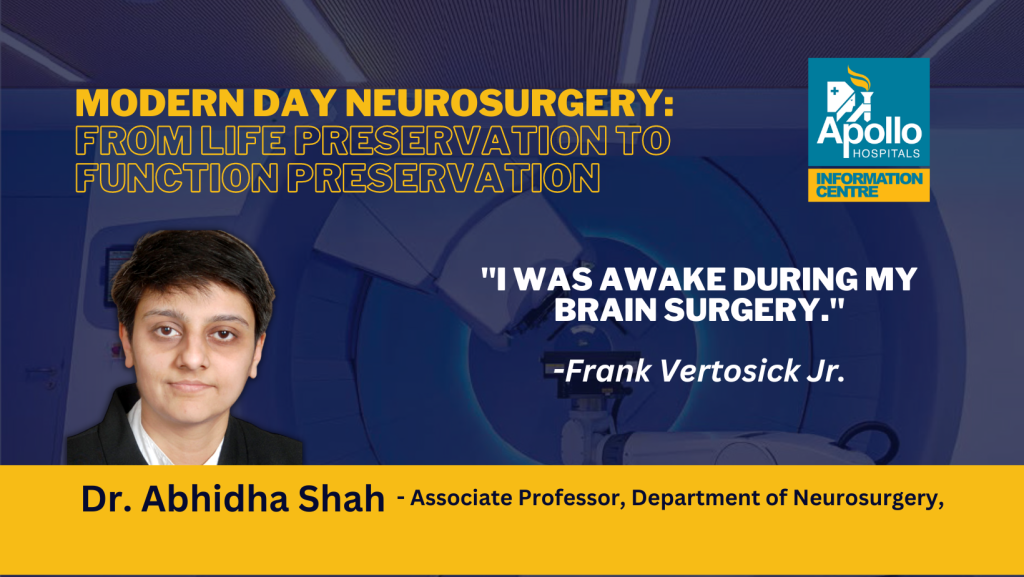
I was awake during my brain surgery. I talked to my surgeon and actually laughed during my surgery”. This is what my patient said to his brother on the evening of his surgery. This patient had a low grade glioma in the left frontal brain which in lay man’s term is the speech area. I performed the neurosurgery with the patient awake so that I would not damage his speech. I could remove the tumor and preserve his speech. The patient comes to me regularly for follow up and recounts the experience as unique and memorable.
Dr. Abhidha Shah
Associate Professor, Department of Neurosurgery,
Seth G.S. Medical College and K.E.M Hospital
Consultant Neurosurgeon, K.J. Somaiya Hospital and Medical College
Consultant Neurosurgeon, Apollo Hospitals, CBD Belapur
The brain is the most magnificent and enigmatic organ of the body and that makes neurosurgery one of the most technically challenging and demanding disciplines of medicine. It is a relatively “young “ discipline having evolved as an organized branch only in the late 1800s and early 1900s. It is however now becoming a rapidly evolving branch as better understanding of the function of the brain and newer technologies merge to create a safe haven for neurosurgeons to operate.
For a long time the field of neurosurgery was considered as a “no man’s land” as the surgical outcomes were often worse than the natural history of the disease itself. The last decade has witnessed the goal of neurosurgery changing from just “saving lives” to achieving a better quality of life that enables the patient to go back to his routine life and occupation. What has changed that makes this possible?
Philosophy of neurosurgery and the neurosurgeon:
Surgery on tumors of the brain is different from surgery for tumors anywhere else in the body where a tumor resection with surrounding tissue with tumor free margins is advocated. In the brain or the spine we neurosurgeons do not have the luxury of resecting normal tissue well beyond the tumor in majority of the patients as this normal tissue contains function, which is essential for the person’s day-to-day performance.
Best Brain Tumor Surgery Hospital
The human neural network consists of “nodes” (cortical areas) connected by a series of “edges or links” (subcortical network) to create the most fascinating grid of motor, sensory, autonomic and emotional function. Understanding this neural circuitry is the key to a successful brain surgery.
I believe that mastering the three dimensional architecture of the brain anatomy is the building block to become an accomplished neurosurgeon. I like to spend hours on end studying the anatomy of the brain and unraveling the secrets it holds.
Brain mapping helps to correlate the anatomy with the functions of the brain and endeavors like the human connectome project help build a map of the surgical arena and the result is a surgical victory. An example of this victory is preserving or improving motor function in a motor strip glioma, preserving the facial function and smile of the patient and hearing in an acoustic neurinoma or making a quadriparetic patient with a craniovertebral junction anomaly walk. This victory is what brings profound satisfaction and allows me to walk tall amongst our breed.
“Only the neurosurgeon dares to improve upon five billion years of evolution in a few hours.
The human brain. A trillion nerve cells storing electrical patterns more numerous than the water molecules of the world’s oceans. The soul’s tapestry lies woven in the brain’s nerve threads.
Delicate, inviolate, the brain floats serenely in a bone vault like the crown jewel of biology. What motivated the vast leap in intellectual horsepower between chimp and man? Between tree dweller and moon walker? Is the brain a gift from God, or simply the jackpot of a trillion rolls of DNA dice?”
— Frank Vertosick Jr.
Neurosurgical Technique and Technology
Technology has rapidly paved its way into neurosurgery. A modern day neurosurgical operation theatre may very well resemble a space station. A “brain suite” has its microscope, neuronavigation station, CUSA, intra-operative ultrasound, neurophysiological monitoring system, endoscope and intra-operative CT/MRI. A hybrid brain suite allows for intra-operative cerebral angiography whilst performing vascular neurosurgeon. The neurosurgeon is at the center of this machinery and dictates the use of each. But all this clutter of gadgetry cannot replace exquisite neurosurgical technique.
Just as the skill of a pilot is measured by his manual flying skills where the maneuvers are carried out by analysis of raw information obtained from airspeed, altitude, weather and heading without use of any modern technology, the skill of a neurosurgeon is measured by his neurosurgical technique.
Mastery of the technical skills of neurosurgery requires great passion and practice, an amalgamation of heart, mind and soul till perfection is achieved. This skill defines the caliber of a neurosurgeon much like an artist in any field. Without this mastery of technique no fancy gadgetry will help you perform good neurosurgery.
All in all neurosurgery is an art. Modern day neurosurgery has advanced to make brain and spine surgery safe. As neurosurgeons we have great responsibility but also have the unique pleasure of seeing a patient become conscious again or walking again or talking again after a good neurosurgical procedure has been performed. There can be no greater joy than this.
For appointments,
WhatsApp – +254 748 830976 / +254 789 150890
Email – info@apolloinformationcentre.cm





